
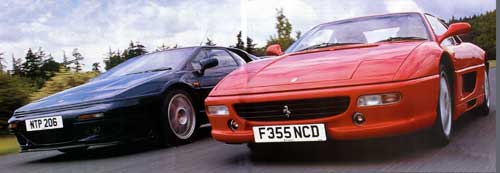
SPLITTING HARES
With its
long-awaited V8 finally in place,
the Esprit was ready to do battle with
the F355,
the best Ferrari ever.
Classics & Sportscars, August
2004
words by Paul Hardiman, photography by Tony Baker
Appearances aren't usually this deceptive. Climb back into the Ferrari after threading yourself in and out of the Lotus' deep, dark cockpit, and if feels like a saloon car. Big windows, all-round visibility, largish wheel, upright seating position. Something's not right. And it's with the Esprit.
Improved and continually updated until it finally received the V8 Lotus has been teasing the motoring press with for years, the Esprit makes do with the same basic architecture of the original wedge wonder launched in 1976. Back then, nobody questioned whether or not supercars were meant to be ergonomically challenged. You sit low, cocooned on all sides by an intimidatingly high transmission tunnel and door, the dash rising up in front of you. Grasp the rubbery steering wheel and try the long reach forward and up to the gearchange – it's not looking good. Five minutes later, if the scenery's been wiggly, you won't want to get out, and not just because it's hard to.
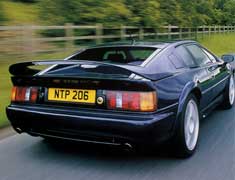
The steering, powered but heavy at low speeds, transforms into a sensitive system of huge depth and precision. The gearchange, while heavy, reliably gets you into the cogs you want when you want them, its sensibly spaced ratios in the first four gears making the Ferrari's six-speeder seem effete and fussy by comparison. The huge gap between fourth and fifth is a clanger, but the engine has enough torque to fill the void. Pulling out and overtaking isn't the game of Russian roulette you'd expect either, because the rear quarter windows are functionally useful. Only rear vision is truly terrible, further impeded by the big hooped spoiler from the stripped-out Sport 300 model, last and most potent of the turbo 'fours'.
All the four-bangers performed miracles on what always felt like marginal power, but this one has real grunt. The all-alloy V8 was a long time coming, arriving in '96, and it's carried high and well forward in the chassis, shouting its presence with a red crackle finish like a Dodge Viper's V10. Rather than the earlier Tony Rudd design devised for the stillborn V8 Project Etna, the Type 918 is an in-house design that was developed in just 27 months. It shares its 3.5-litre capacity and number of camshafts – four – with the Ferrari, but has two Garrett T25 turbochargers, where the Ferrari makes do with an extra valve per cylinder. But what a difference the hardware makes. After the aural excellence of the Ferrari, the Lotus is a disappointment. It sounds better from outside than in, erupting from rest like a Detroit muscle car. It pops and pings at tickover through its sports exhaust like a mellifluous wind chime. Yet, on the prowl, it's oddly unmoving. The flat-plane crank renders all the excitement within into a dull note, further damped by the blowers.
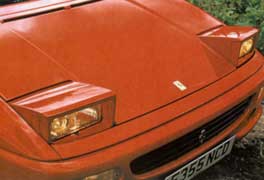
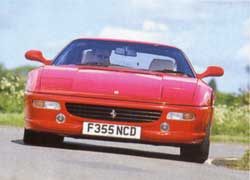
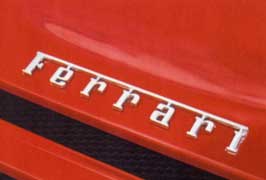
At least the 3.5-litre unit produces monster torque: 295lb ft at 4250rpm, nearly 30lb ft more than the Ferrari, which needs almost another 2000rpm to reach maximum twist. In the first two gears, boost is limited to 0.5bar to save the gearbox – the same Renault 30/GTA-derived transaxle beloved of GT40 replica builders but now with synchromesh on reverse – but the Lotus always has the grunt to chirrup the huge rear tyres and unsettle the traction. The chassis is so well behaved it hardly notices. The clutch is heavy, matching all the controls that belie Lotus' light-weight reputation with a meaty feel. It sounds dull and agricultural beside the creamy Ferrari, but it starts getting interested at 3500rpm, wanting an upchange at 7000rpm just before it hits the rev limiter, and will hold off the 355 through the gears until the Ferrari reaches its torque peak at 6000rpm and climbs on towards hyperdrive. That crucial 80-100mph overtaking time in fourth is an identical 3.6 secs in both cars.
The F355 Berlinetta was launched at the Geneva Salon in 1994, the latest in a long line of mid-engined junior supercars that stretched right back to the Dino. Twelve months later, the open-topped GTS version became available and, in 1988, the F1 version with paddle gearshift hit the roads just in time to spoil Lotus' glory as the V8, of which 400 a year were planned, finally came on stream. The 355 and its predecessor, the unloved 348, wear their V8s longitudinally, with a host of cleverness such as five valves per cylinder and electronically controlled dampers.
Making modern Ferraris easy to live with does not diminish the thrill of hearing either V8 or flat V12 whirr on the starter and then whang into life in an explosion of all things good and combustible. This V8, also with a flat-plane crank but sounding as it it has conventional 90° throws, has a sports exhaust, too: subdued in town, but taking on a harder edge that rises to a mighty howl by 6500rpm. But this time it's really moving, but there's more. The motor is tuned for power, not torque, with its claimed maximum of 380bhp appearing at an eye-watering 8250rpm. It'll reach this time and again in the lower gears with no apparent ill effects, and at its maximum of 173mph is spinning at 8310rpm.
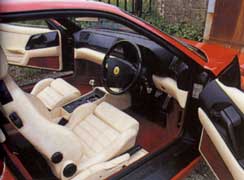
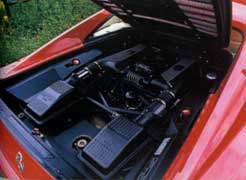

It's a technical masterpiece – in its day, it produced the highest specific power output for a normally aspirated Ferrari engine – using two exhaust valves and three inlet valves arranged radically. These are not the nightmare to set up you'd expect because there are hydraulic tappets, a first on engines revving this high. Ferrari claimed that up to 10,000rpm would have been available before resonance set up in the double valve springs. Conrods are titanium alloy, previously seen only in F1 engines, and the Bosch Motronic management system fires the fuel via individual throttles for each cylinder. There are two catalysts, one ceramic and one steel bypass matrix, to which hot gases are fed at higher speeds when the Motronic opens a throttle valve in the exhaust system.
The F355 – Ferrari, 3.5 litres, five valves per cylinder – is always perfectly civilised: no special techniques needed, just turn it on and drive it down to the shops. Power steering is light enough to take the strain out of manoeuvring, brakes are rock-hard with good pedal feel, although still offset slightly to the left to clear the big wheelarch, and even second gear is available from cold, which will be anathema to Ferrari diehards. The lever simply slap-clacks around the open gate with an easy action, matched by the clutch, which is light but easy to control and gives no sense that it's dealing with hundreds of horsepower. There's even room for some small cases in the front, which is just as well, because there's no storage space in the rear – it's full of plumbing and trunking, including the paired as plenums, individually numbered in the same way Weber carburettor used to be.
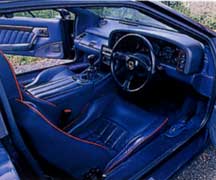
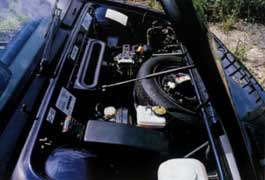
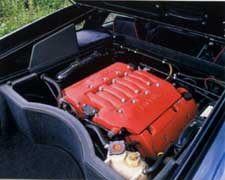
Lotus goes about its packaging rather differently. There's a decent-sized storage bin behind the engine, which sits higher than the Ferrari's dry-sumped unit, and it's shaped to carry a rear wheel if the space-saver spare is in use. This lives in the front, along with radiators, reservoirs, brake booster and anti-lock pump, plus some rather ugly glassfibre matting. You might pack some small tools in there, but no proper luggage.
Both dashboards are a little disappointing: the Ferrari's dials while clear and easy to read, have nasty painted sliver rims like a current plastic hatchback's; the Lotus binnacle looks as if it was nicked from a Cowley-built Princess. At least the walnut finish on the early V8s makes you laugh. And Ferrari needn't be too sanctimonious about he English car's vast toytown pushbuttons – it has persisted with the trumpet-plunger rocker switches that should have been left behind in the Daytona and tried to update them with a black plastic finish.
Detail aesthetics that might once have seemed a good idea are now, thankfully, irrelevant: these cars are for driving. Thanks in part to the electronic damper control, the Ferrari rides uncannily smoothly and feels neutral most of the time. If you do manage to boot the tail out on the power, the 355 isn't easy to catch, partly due to inertia and partly because the low-geared steering lacks feel.
The Lotus feels more secure, even though it squirms around more and has a greater differential between front and rear tyre sizes than the 355. Pulling away, the Ferrari's limited-slip differential feels pretty tightly wound up, but doesn't manifest any nasty habits on the road. There are two settings for the dampers: Sport or Comfort, but you're hard pushed to tell the difference. The Esprit is, simply, near faultless, able to carry great speed through corners with a secure feeling that comes from the knowledge that, should you overdo it, its razor-sharp reactions will go a long way towards helping you get it back.
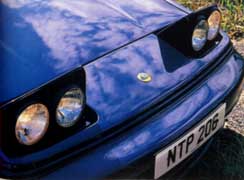
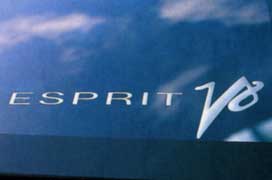
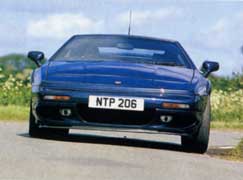
The Lotus looks surprisingly youthful for a reskinned 21-year-old design. Giugiaro styled the original car, which was cleverly updated by Peter Stevens in 1987. On this car – built in '96, the first year of V8 production – the original shape has been subsumed by a wealth of air intakes, a wingletted spoiler and wheelarch eyebrows, but the effect manages to look menacing rather than messy, especially from the rear. In 2001, more revisions were done by Russell Carr: the Celica tail-lights were dropped and four round lamps substituted (sound familiar?), side skirts were changed and OZ wheels added. Inside, the dash was updated under a modern curved binnacle.
On the Ferrari, it's hard to believe how much difference ditching the side strakes makes – the main difference between the 355 and the 348, which share the same basic structure. Although designed and built by Pininfarina, it closely mimics the 348 Zagato Elaborazione, announced in 1991, of which 12 were built out of a planned 20. The 355 uses similar tail-light clusters and side scoops. It doesn't need spoilers because, according to Pininfarina, the shaped underbody prevents lift. Air is ducted through the doors to feed the engine. Neat and compact, this is one of the best-looking Ferraris ever.
Both cars represented great leaps forward from their predecessors. The Ferrari is so good, it's hard to believe there's a lot of 348 in it. The most complete Ferrari to date was surpassed only by the 360 and is a popular secondhand buy today. Lotus booted the 20-year-old Esprit along with a giant stride in '96, but only really finished it in 2001 – just in time for it to be killed off at the end of 2003. The Ferrari remains super-desirable in both looks and deportment, and makes a fabulous noise. You'll be noticed in it, for sure. But at today's money it's twice the price of the Lotus, which not only handles better but has a wicked presence all of its own.
Thanks to Talacrest for the loan of the Ferrari, which is for sale at £53,000 (tel: 01784 439797) and to Nick Procter for the loan of his Lotus Esprit.
|
|